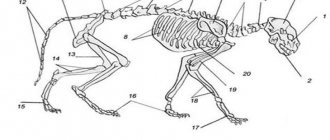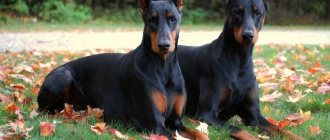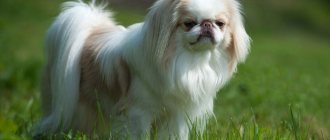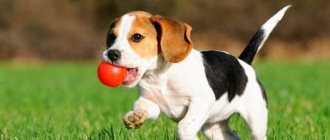The tail is a very important part of the dog's body, in fact it is an extension of the spine - an appendage that consists of muscles and bones that allow it to move in any direction and the animal to control the movement of the tip or the entire appendage. Its original purpose is to maintain balance while moving.
The tail is used as a steering tool, necessary when performing complex maneuvers such as jumping, climbing and descending, walking on narrow surfaces, and turning while running.
Most animals that are characterized by a love of running and speed have long and thin appendages that serve as a counterweight when making sharp turns while moving at high speed. Natural swimmers, on the contrary, have thick and strong tails, they help animals stay afloat and change direction of movement. Sled and server breeds have fluffy tails; they help protect the head and muzzle from the cold while resting and sleeping.
If a dog is chasing its tail, this should not always be attributed to playful behavior; there may be several reasons for this, in particular a nervous disorder, a panic attack, lack of attention (as a way to attract attention), but puppies often chase their tail out of curiosity.
Puppies are born without the ability to wag their tail. Most of them begin to communicate using it at about one and a half months.
It is interesting to know that pets do not wag their mobile appendages when they are alone, because there is no need for this.
Structure of a dog's tail
The dog's tail is a natural extension of the spine, consisting of 15-23 vertebrae. The exact amount depends on the breed and determines the length of the tail.
Another difference can be seen between the shape of the process. Its appearance may resemble:
- saber (great Danes, collies, Dalmatians);
- sickle (chow-chow, husky, spitz);
- ring (malamutes, pugs, lap dogs);
- twig (pointers, setters);
- log (Newfoundlands, St. Bernards, Labradors);
- hook (Bedlingtons, South Russian and Caucasian Shepherds);
- feather (setters, Atlas Shepherds).
When dogs with different tails are crossed, most of the puppies inherit the curled shape.
Please note that mating of two short-tailed pets is not allowed. The mutant gene responsible for this anomaly leads to a significant reduction in litter size as a result of damage to the spinal cord.
Tail steering
Looking at a dog that is moving, it is noticeable that the tail is actively involved in this process. It helps the animal balance when the dog walks on logs or uneven surfaces. Also, thanks to the tail, dogs can abruptly change trajectories, this is especially important for dogs that develop enormous speeds - greyhounds, hounds.
In addition, the tail helps dogs swim, because it is not for nothing that all water breeds - Labradors, Newfoundlands, Irish Water Spaniels, Portuguese Water Dogs and others - have a rather long and thick tail. It helps the dog swim long distances, dive and swim to the surface.
Why does a dog need a tail?
The caudal vertebrae are surrounded by many nerve endings. If you pull or pull a dog by the tail, then, in addition to acute pain, you can provoke problems with the coordination of the paws and the urinary system. For this reason, you should treat this organ with care and prevent it from being damaged.
The interaction of the brain and nerves clearly explains why a dog needs a tail. With its help, she can show her emotions by communicating with other animals and humans. The tail is also responsible for balancing the body, allowing you to maintain balance and direction in different situations.
Demonstration of mood
By the position and movement of a dog's tail, you can guess its mood. Once you become familiar with the basic positions, you will be able to better understand your pet.
Communication
By sniffing each other's tails, dogs remember the unique smells of new acquaintances - or identify their friends.
A special secret produced by the paraanal glands is responsible for the individual aroma. With its help, animals mark their territory and attract the opposite sex.
The high tail allows you to spread this smell around, scaring away potential rivals. If your pet finds himself in an unfamiliar place, then most likely he will try to hide his presence. In this case, its tail will be lowered.
Sense of space and balance
A dog's tail can be compared to a rudder or balance beam in the hands of trapeze artists. It helps you change direction while moving and maintain balance on shaky surfaces. While swimming, the tail takes on part of the load from the paws, so don’t be surprised if your four-legged pet beats you in a long-distance swim.
Mood
Why else does a dog need a tail? To “tell” the owner and others about your mood. The position and movement speaks volumes about what the pet is currently experiencing:
- peace and tranquility - when the dog is happy with everything and is calm; its tail is in a relaxed state and is positioned depending on the characteristics of the breed: in a husky it is curled into a tight ring, in a pug it lies on its back, in a Labrador or shepherd dog it hangs freely;
- a light waving from side to side indicates a good mood and goodwill, while intense wagging or movements reminiscent of the movement of a propeller indicate unbridled happiness and joy;
- tightly pressed, lowered or clamped - indicates the pet’s readiness for submission, fear or anxiety;
- raised high, slightly swaying - serves as a manifestation of aggression;
- straight as a pipe, raised high - means the animal is wary.
Knowing this simple “language” of the tail, you will always know what mood your pet is in.
What do dog tail movements say?
Having found out why a dog needs a tail, all that remains is to decipher the emotions it demonstrates. The most common ones can be found in the table below.
| Ponytail position | Meaning |
| Down and wobbling | Submissive posture, sadness or malaise |
| Fixed and parallel to the back | Aggression |
| Raised vertically upward, tense and motionless | Tension when encountering something unfamiliar (sound, smell, person or other animal) |
| Down and relaxed | Calmness or indifference |
| Raised upward and wobbles vigorously, resembling a propeller | Friendliness or playfulness |
| Parallel to the back and wagging | Wariness, which can give way to aggression and attack |
| Raised up and very tense, only the tip wags | Ready to attack |
| Tucked to the stomach | Fear, anxiety or submission |
Please note that in some dog breeds, a tucked tail may convey completely different information. In Italian greyhounds, this position indicates calmness and friendliness, so be sure to take into account the structural features of your pet’s body.
What do we have in common with our four-legged friends?
For each type of animal, the tail performs its own functions. In kangaroos it is a support when jumping. Cows need a tail to escape annoying insects.
Maybe it will even be news to someone that we humans also have a tail. No, not among those primitive ape-men, but precisely among us, the modern inhabitants of the Earth. Yes, yes, at an early stage of its development, the human embryo boasts a small tail, which grows when the spine is formed. This tail subsequently stops developing and turns into a tailbone. Therefore, it is worth noting that it turns out that we and our four-legged friends have a lot in common.
Why does a dog wag its tail and what does it mean?
A dog's tail is constantly in motion, and its wagging can convey completely opposite emotions. If the animal is in a good mood, then the movements of its tail are directed to the right, and if in a bad mood, to the left.
When communicating with each other, four-legged pets pay attention not only to the position, but also to the length of the appendage of their opponent. Long-tailed individuals receive the most respect. There is a possibility that this is due to easier interpretation of the signals given. But short-tailed dogs are often subject to aggressive attacks, so it is better not to let them go too far alone when walking.
Use for territory marking
Another important reason why a dog needs a tail lies in the peculiarities of the location of the paraanal glands, which produce a special smelling secret with which the animal marks its territory. These glands look like small sacs and are located at the exit from the anus. They produce and accumulate a special substance that is responsible for the individual odor of each dog. This smell is also a means of communication, but exclusively between animals.
Most often, dogs leave their “marks” through feces, since feces coming out of the anus stimulate the secretion of secretions and emptying of the glands. But in some cases, wagging the movable tail is also used for the same purpose.
Such movements cause the release of an odorous substance and the spread of an individual odor. At the same time, dominant dogs raise it as high as possible so that their fluids diverge as far as possible. And timid or frightened ones, on the contrary, tuck their tails between their legs so as not to attract the attention of other, more aggressive individuals.
The dog is chasing its tail
Many owners have repeatedly observed how their dogs chase their own tail. But not everyone knows that such behavior can signal serious deviations. The accompanying signs will help you find out about this.
Norm
Dogs chase their tail at a young age when they do not fully understand its meaning. Over time, puppies lose interest in him, so don't worry if your four-legged baby is playing too enthusiastically with his tail. Typically, such hyperactivity is observed after returning from a walk or when meeting the owner.
If an adult dog is busy chasing, then most likely he is just bored and is trying to attract your attention. It is worth looking for the cause of deviations only when the duration and frequency of strange behavior begin to increase.
Deviations
The presence of pathology can be determined by behavioral and physiological symptoms. The former include apathy, unreasonable aggression, whining and poor appetite, and the latter include itching, redness of the skin, rapid breathing and fever.
Among the main pathological reasons that prompt a dog to chase its tail are:
- mental disorders including OCD and panic attacks;
- infections;
- parasitosis;
- hepatoencephalopathy, accompanied by damage to the nervous system against the background of liver pathologies;
- allergies;
- traumatic brain injuries;
- dysfunction of the vestibular apparatus;
- ophthalmological diseases that reduce visual acuity.
All these deviations require different treatment regimens, so the sick animal should make an appointment at the veterinary clinic. Thanks to timely diagnosis, the problem can be solved before complications arise.
Cupping
Dogs without tails do not exist in nature. Scientists tried to breed such a breed, but it did not lead to anything. Therefore, some dog breeds have their tails docked. The only advantage of tail docking for dogs is that it is safer when following commands. This applies to hunting breeds, when dogs chase predators and there is a possibility for the dog to be caught by the tail. Accordingly, in the absence of a tail, this probability decreases. This also applies to animals serving in various organs.
The research work of scientists tells us about the disadvantages of docking, which is that this operation causes trauma to the dog, both physical and psychological. If this operation is necessary, it is better to perform it on the puppy in the first week of life.
IMPORTANT! If the surgery is unsuccessful, the dog will be in constant pain.
The psychological trauma of docking is the inability to communicate with other dogs using the tail. All this often leads to a deterioration in the character and behavior of the animal.
Genetics and breeding practices.
As a breeder, you need to deal with tails that are atypical according to the standard. The shape of the tail and the manner of carrying it are inherited. And about the “fight”, I would like to quote one phrase from my girth (a famous Sheltie breeder in Russia), she once said that breeding dogs is an amazing thing. First, people INTRODUCE defects into the breed, and then they FIGHT them intensively. I really liked this statement, short and succinct. No need to deposit! And then there will be nothing to fight with.
As for my practice and observations, there is no very clear rule for the inheritance of bad tails. There are breeders with very poor tails who very much pass on their “signature” tail shape from different mothers. At the same time, there are also sires with bad tails, but from mating with bitches that have correct tails they produced almost all offspring with good tails. In my kennel I have never made such combinations as to pair a bitch with a tendency to a curled tail with a dog with a bad tail, and therefore, it is difficult for me to say what happens in such cases, but I think that nothing good can be expected in this case. Even from two dogs with good tails, most puppies will have good tails, but it is absolutely not guaranteed that all of them will.
In conclusion, I would just like to note that when a breeder chooses a very beautiful male dog for his bitch, but with a bad tail, he must clearly understand that there will be no miracle and that defects are inherited just as much as advantages.
author: Elena BALAZOVICH
Animal balancing tool
The tail is one of the important parts of a dog's body. It is a continuation of the spine, so any injuries to the tail will negatively affect the health of the entire body. With active movement while running and walking, the dog helps itself to choose a more accurate direction. Therefore, the tail is the dog's main balancing tool.
In addition, when swimming, it helps to swim a long distance, relieving the load from the dog’s paws. If the tail in the water is perpendicular to the body, the pet will be able to feel more stable and lighter in the water.
How does surgery change depending on age?
If done on time, the puppies will experience minimal discomfort. Tail cutting sounds terrible in words, but in reality it's different. The veterinarian takes the baby out of the box, quickly processes the tail and cuts it off with special scissors. A short squeak is heard and the puppy returns to his brothers. Within a minute he goes back to bed. That is, the operation is performed without anesthesia and pain relief. Ossification of the tail vertebrae has not yet occurred, and sensitivity is lower than in adults.
Tail as an odor blocker
In order to deepen the understanding of this important function, it is necessary to first explain such a physiological detail as the paraanal glands. Many owners do not even have an idea about these glands, since it is very difficult for someone inexperienced in zoology to recognize their influence on the dog’s life.
The paraanal glands require periodic care to avoid inflammation.
Externally, the paraanal glands resemble small sacs that are located at the exit from the anus of the animal. Over time, the bags are filled with a specific secretion, which is capable of emitting its own individual smell. This smell is an element of a complex system of interaction between dogs.
Functions of the paraanal glands
The paraanal glands acquire the greatest importance during the period of sexual readiness, since they perform the following two important functions:
- notify the hypothetical sexual partner that the individual is ready to mate;
- notify the animal’s rivals about its plans for a partner and its readiness to fight.
The anal glands are an important tool in canine communication.
The smell emanating from the secretion can either actively spread or be drowned out - it all depends on the dog’s intentions and mood. By actively waving its tail, the animal uses it as a fan, thanks to which the smell of the secretion spreads faster, thereby spreading information about the presence of the dog. If a dog does not want to be recognized and participate in any communication with its relatives, it deliberately presses its tail to hide its presence.
As a rule, acquaintance with the paraanal glands occurs when they become inflamed in a dog and require treatment. You can read below about how to avoid this painful phenomenon for your dog and learn how to flush these glands.
Cleaning the dog's anal glands
The tail is a method of transmitting smell
At the base of the dog's tail are the paraanal glands, which contain a special secretion with its own individual scent. If an animal is confident in itself, it waves its tail to spread its scent, make itself known, and tell the relatives around it who exactly is in front of them. In addition, such actions attract individuals of the opposite sex. But if it is afraid or frightened, it pinches it under the stomach, preventing the smell from spreading. This is a kind of attempt not to attract attention to oneself.
All this happens provided that the anal glands are not blocked, which happens quite often. If this happens, then in this video you can learn how to clean the anal glands in dogs yourself.
The sacrum and the structure of the hindquarters in a dog
The sacrum is the section of the spine between the lower back and the tail, the sacral vertebrae (there are three, very rarely four) firmly connect the spinal column with the hind limb, while they experience significant physical stress, both statically and dynamically, so these vertebrae are fused into a single sacral bone, which is firmly connected by a fixed joint to the pelvic bone. The fit of the tail depends on the inclination, length and curvature of the sacrum. With a more inclined and longer sacral bone, the tail set will be lower. The slope of the sacrum coincides with the slope of the pelvic bone because they are rigidly attached to each other. The slope of the croup in a living dog depends on the inclination of the pelvic bone.
Here I would like to make one clarification. In different canine literature, the croup area is designated differently. At the same time, the entire area of the pelvic bone is the croup, i.e. on a living dog, the length of the croup is determined by the distance between the slope and the ischial tuberosity, which will exactly correspond to the length of the pelvic bone.
The correct length and slope of the croup (pelvic bone) is very important in the design of the hind legs. The sacral bone does not have any influence on the structure of the hind limb. One can observe a large number of dogs with excellent length and slope of the croup and correspondingly good structure of the hind legs, but with a short rump, which, of course, leads to a high carriage of the tail.
I am writing this in order to refute the frequent opinion that if the tail is set high, then it necessarily does not have the correct structure of the hind limb. Very often this actually coincides if an incorrect tilt of the pelvic bone (for example, not tilted enough) leads to an incorrect tilt of the sacrum and a correspondingly higher than necessary host landing. But often a high tail set is caused only by an insufficiently long sacral bone, while the length and slope of the croup and, consequently, the structure and function of the hind limbs are good.
By the way, usually more “prosperous” tails in bitches are explained not only by their less pronounced dominance. Bitches have a relatively longer rump than males, which results in a slightly different lower tail set.











